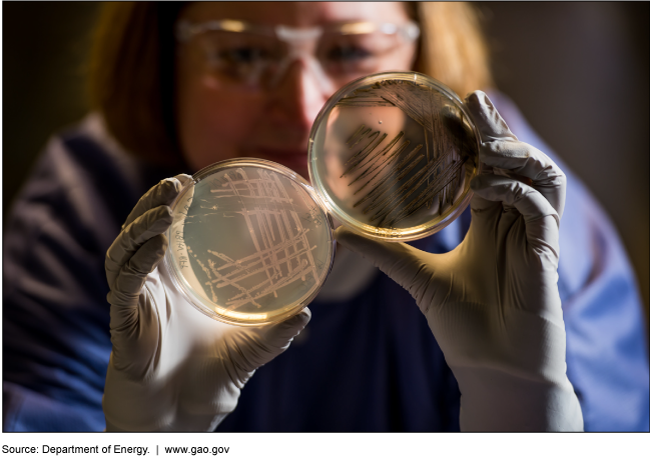Biodefense: The Nation Faces Long-Standing Challenges Related to Defending Against Biological Threats
Fast Facts
While the biotechnology revolution presents opportunities for scientific breakthroughs, in the wrong hands these technologies could help create biological weapons with catastrophic impacts.
How do we defend against these and other biological threats, including naturally-occurring diseases?
We testified before a House committee on our work on the nation's long-standing biodefense challenges. We identified key challenges in the nation's ability to detect and respond to biological events that transcend what a single agency can address. For example, agencies need to work together to assess the relative risk from a variety of biological threats.

Woman looking at two Petri dishes.
Highlights
What GAO Found
GAO's past work has identified a number of challenges related to the nation's ability to detect and respond to biological events that transcend what any one federal department or agency can address on its own. They include, among others:
- Assessing enterprise-wide threats. In October 2017, GAO found there was no existing mechanism across the federal government that could leverage threat awareness information to direct resources and set budgetary priorities across all agencies for biodefense. GAO said at the time that the pending biodefense strategy may address this.
- Situational awareness and data integration. GAO reported in 2009 and 2015 that the Department of Homeland Security's (DHS) National Biosurveillance Integration Center (NBIC)—created to integrate data across the federal government to enhance detection and situational awareness of biological events—has suffered from longstanding challenges related to its clarity of purpose and collaboration with other agencies. DHS implemented GAO's 2009 recommendation to develop a strategy, but in 2015 GAO found NBIC continued to face challenges, such as limited partner participation in the center's activities.
- Biodetection technologies. DHS has faced challenges in clearly justifying the need for and establishing the capabilities of the BioWatch program—a system designed to detect an aerosolized biological terrorist attack. In October 2015, GAO recommended that DHS not pursue upgrades until it takes steps to establish BioWatch's technical capabilites. While DHS agreed and described a series of tests to establish capabilities, it continued to pursue upgrades.
- Biological laboratory safety and security. Since 2008, GAO has identified challenges and areas for improvement related to the safety, security, and oversight of high-containment laboratories, which, among other things, conduct research on hazardous pathogens—such as the Ebola virus. GAO recommended that agencies take actions to avoid safety and security lapses at laboratories, such as better assessing risks, coordinating inspections, and reporting inspection results. Many recommendations have been addressed, but others remain open, such as finalizing guidance on documenting the shipment of dangerous biological material.
In September 2018, the White House issued the National Biodefense Strategy and associated plans, which could help to address some of the ongoing challenges GAO has previously identified. However, because implementation of the strategy is in early stages, it remains to be seen how or to what extent the agencies responsible for implementation will institutionalize mechanisms to help the nation make the best use of limited biodefense resources. GAO is currently reviewing the strategy and will report out later this year.
Why GAO Did This Study
Catastrophic biological events have the potential to cause loss of life, and sustained damage to the economy, societal stability, and global security. The biodefense enterprise is the whole combination of systems at every level of government and the private sector that contribute to protecting the nation and its citizens from potentially catastrophic effects of a biological event. Since 2009, GAO has identified cross-cutting issues in federal leadership, coordination, and collaboration that arise from working across the complex interagency, intergovernmental, and intersectoral biodefense enterprise. In 2011, GAO reported that there was no broad, integrated national strategy that encompassed all stakeholders with biodefense responsibilities and called for the development of a national biodefense strategy. In September 2018, the White House released a National Biodefense Strategy.
This statement discusses GAO reports issued from December 2009 through March 2019 on various biological threats and biodefense efforts, and selected updates to BioWatch recommendations made in 2015. To conduct prior work, GAO reviewed biodefense reports, relevant presidential directives, laws, regulations, policies, strategic plans; surveyed states; and interviewed federal, state, and industry officials, among others.
What GAO Recommended
GAO has made numerous agency recommendations in its prior reports designed to address the challenges discussed in this statement. As of June 2019, agencies have taken steps to address many of these, and GAO is monitoring ongoing efforts.
For more information, contact Chris Currie at (404) 679-1875 or curriec@gao.gov.
